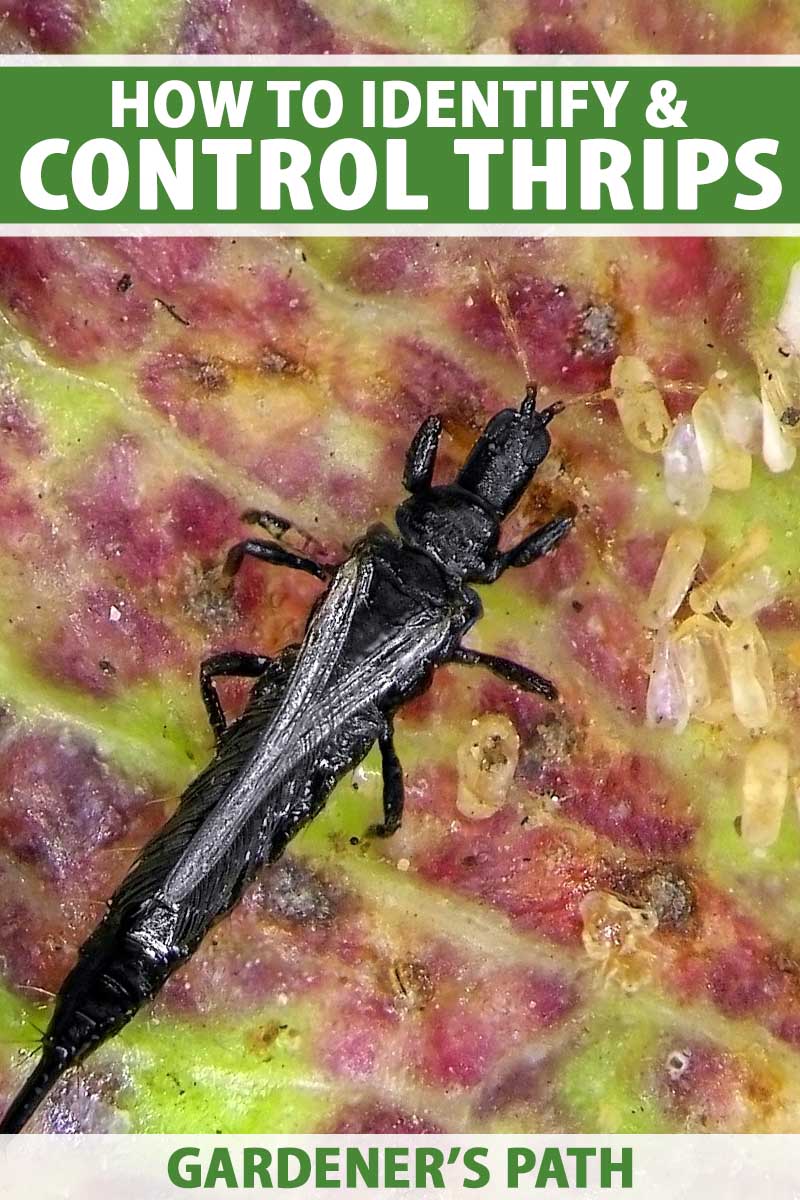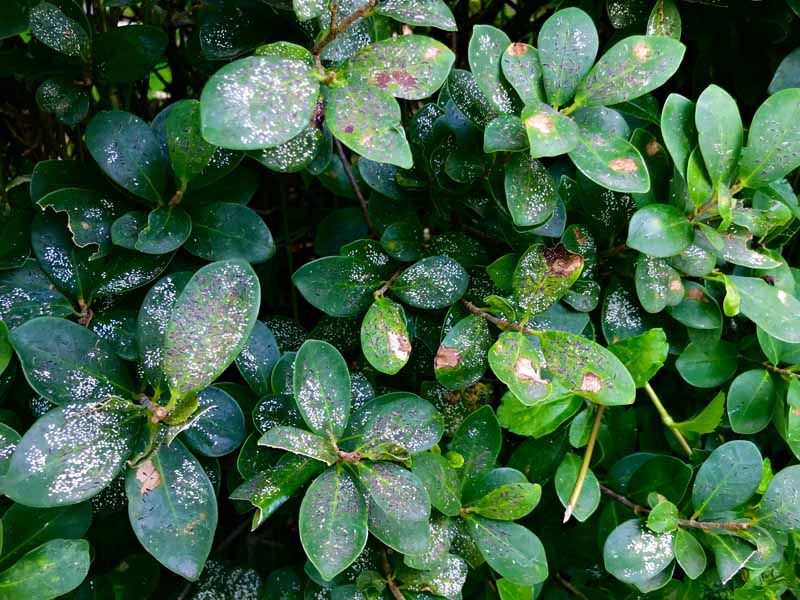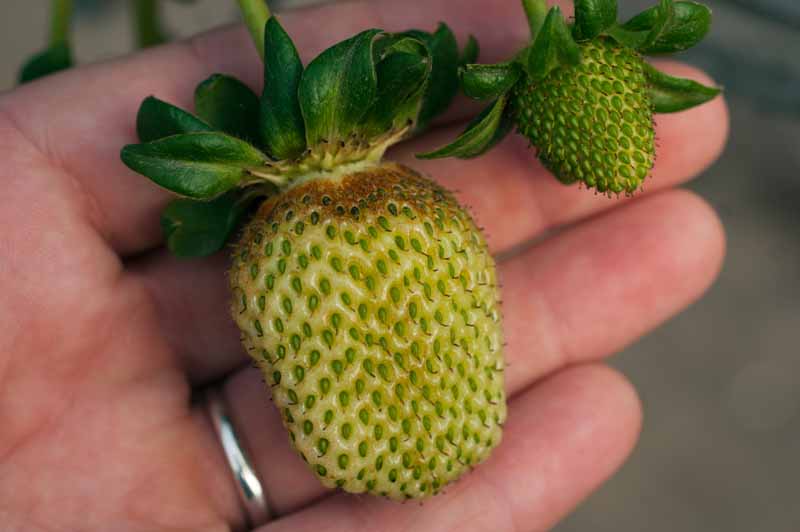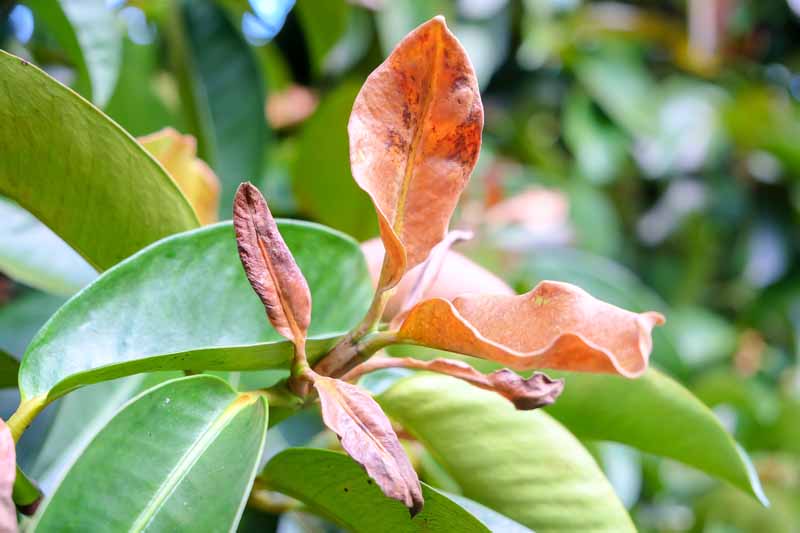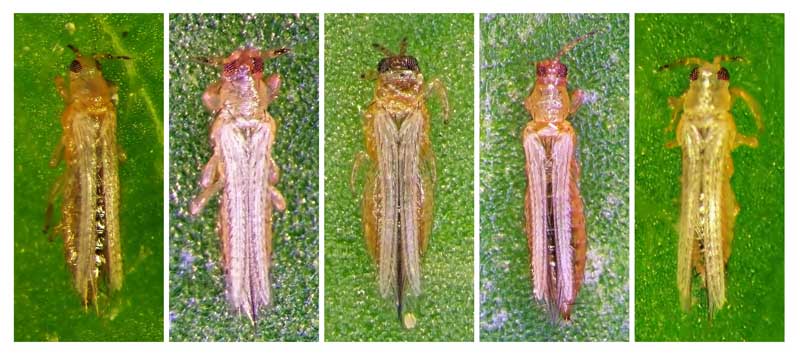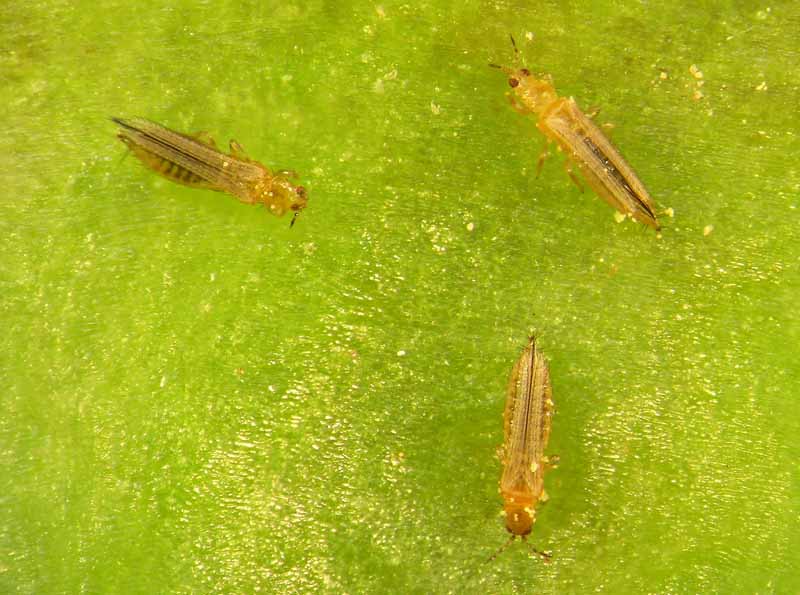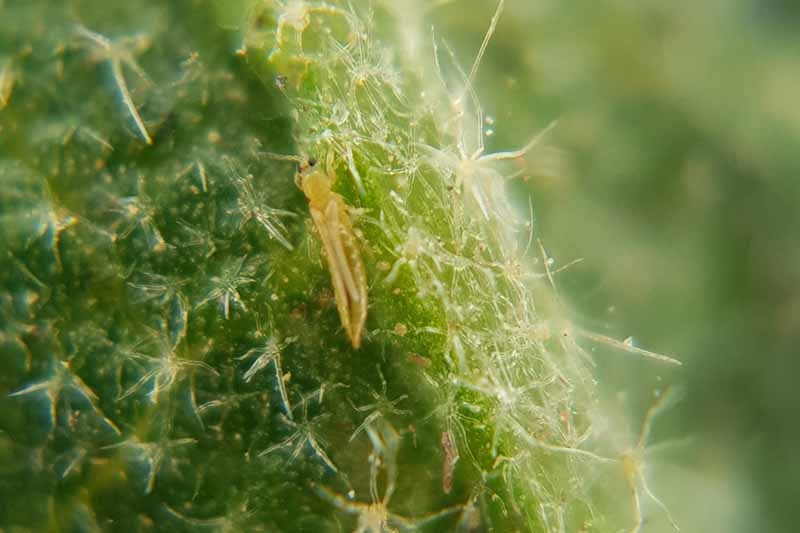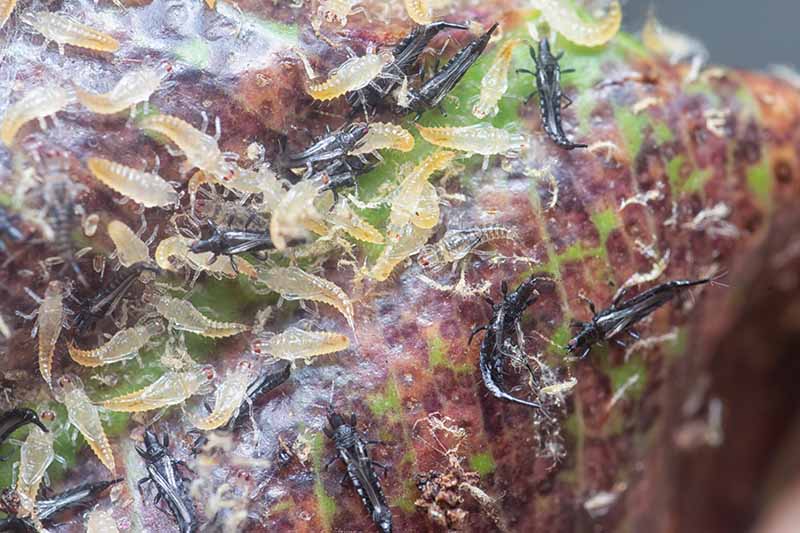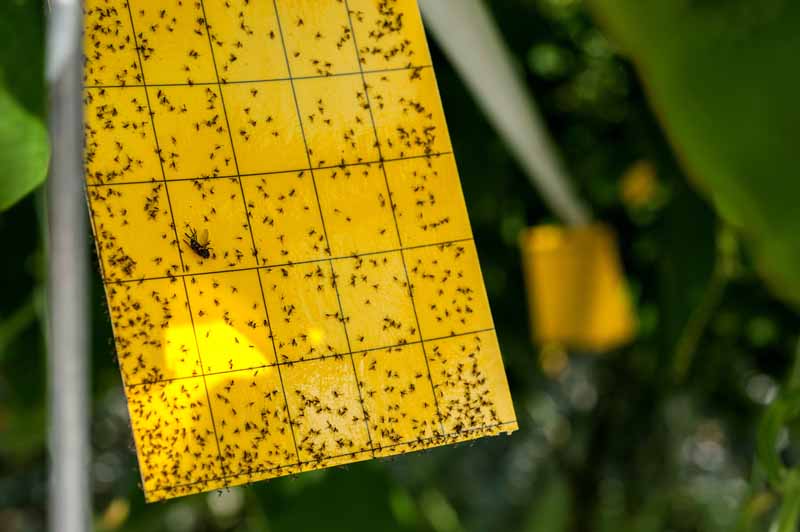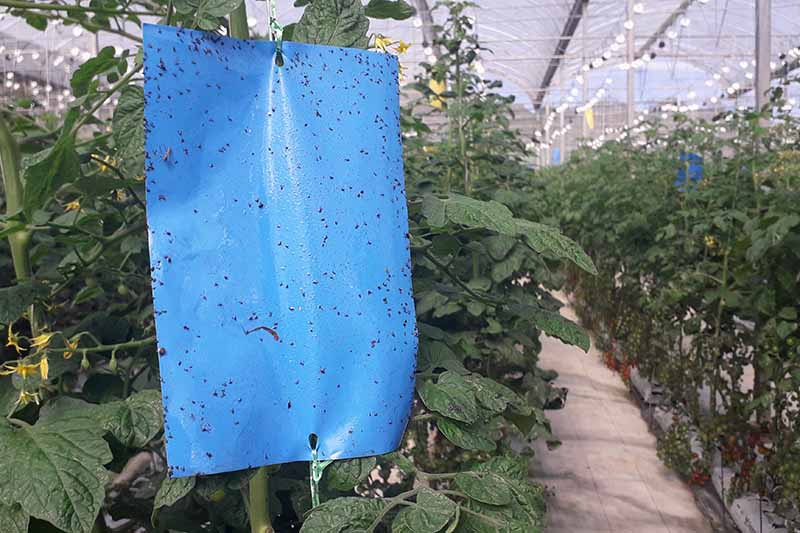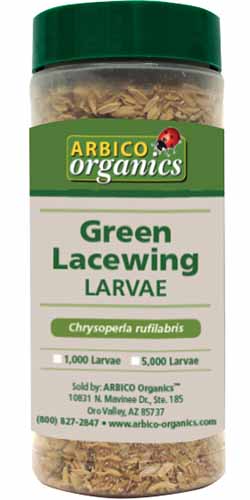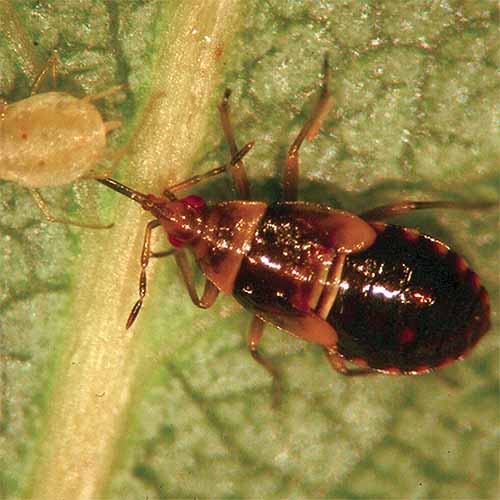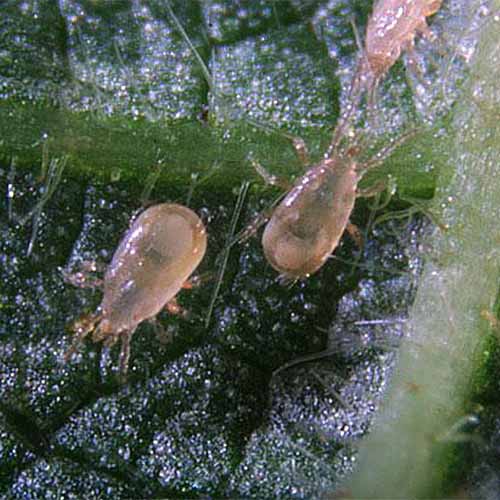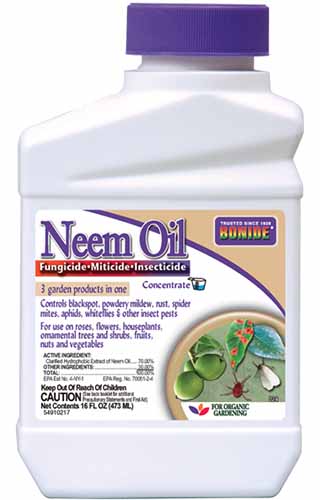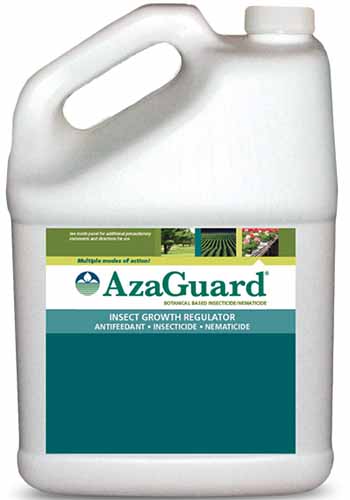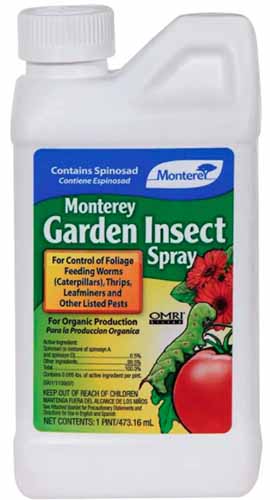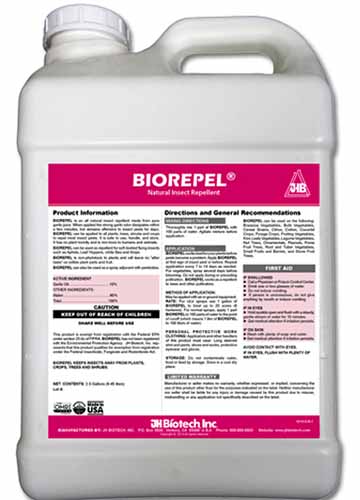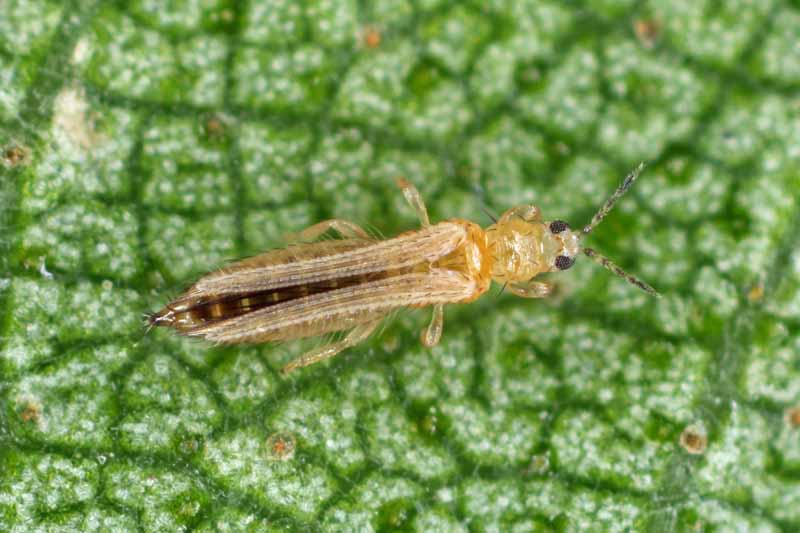The result: scarred flowers, deformed leaves, and discolored fruit. Not exactly what you had in mind when you planted your garden this year, is it? If you’re growing flowers, vegetables, or fruits, you’ll want to know a few things about Thysanoptera pests. That way, if they do appear, you’ll understand what they are and how to deal with them. We link to vendors to help you find relevant products. If you buy from one of our links, we may earn a commission. We’ve got you covered. Everything you need to know about these guys is below!
What Are Thrips?
Thrips are in their own order, Thysanoptera, which includes over 5,000 species. Some are beneficial predators, such as the six-spotted thrips which prey on pest mites. Some feed on fungal spores and pollen. And then there are the plant pests, which are common, damaging, and polyphagous, meaning each species feeds on a variety of unrelated plants. Pest species affect over 500 species of plants from temperate climates to the tropics. And yes, it’s one thrips, two thrips. The singular and plural forms of the name are the same! (And it might as well always be plural, because where there’s one, there are usually a lot more, thanks to a quick reproductive process…). They have rasping, sucking mouthparts which scrub and puncture the surface of plant tissues and sip the exuding sap. Some even inject digestive enzymes as they feed. Feeding results in stippling, discoloration, and scarring on fruits, leaves, flowers, and buds; tissue distortion; and stunted growth. Egg laying results in scars and yellow halos. If they inject enzymes, silver or bronze speckles will appear. As if that wasn’t enough, they vector pathogens as well, and leave small kernels of black frass (insect poop) wherever they feed. The damage can be confused with that caused by other sucking insects and mites that cause stippling. Most of this damage is cosmetic, and fatal damage is rare. Young herbaceous ornamentals and vegetables are more susceptible to feeding damage, but the biggest threat is the incurable Tospoviruses they vector. Impatiens necrotic spot virus (INSV) and tomato spotted wilt virus (TSWV) can both severely damage or kill certain veggies and ornamentals, so it is important to control infestations of these tiny insects. INSV symptoms vary. Spots, sometimes described as visually similar to brown chicken pox or ringed spots, as well as stem death, stunting, and yellowing, can’t confirm the presence of this virus, but these symptoms should alert you to an issue. TSWV presents with bronzed upper leaf surfaces, necrotic (dead, brown) spots, and sometimes distorted leaves that are cupped downwards. Look out for concentric, chlorotic (yellow or light colored) rings on fruit. Thrips are the biggest factor in the spread and treatment of these two viruses, so keep reading to learn how to identify and control these little suckers.
Identification
Often described as cigar or bullet shaped, these insects are no bigger than one millimeter in length. They have fringed wings, and translucent white or yellow to deep brown or black bodies. If you see a small, slender insect crawling on flower petals or leaves, use a hand lens with 10x magnification or higher to have a better look. It can be very hard to identify species in the field. You can use clues such as their behavior, appearance, and what plant they are feeding on to help identify them as closely as possible, but body color is not a perfectly accurate metric. If you need or want to know exactly which species are present, enlist an expert. While similar control options will work on most species, it can be important to know the difference when using an integrated pest management strategy that includes biological controls, as some natural enemies provide better control for certain species over others. Plus, just because you find thrips, it doesn’t mean you need to whip out the chemicals. Even if it is a pest species, many are harmless if they aren’t found on their preferred host. For example, the infamous Western flower thrips do not damage avocados, but you will sometimes find them hanging out on avocado plants. Here are a few common types you may find in your garden: Western flower thrips, Frankliniella occidentalis, is very common and it is the number one thrips pest of herbaceous plants. It is a significant vector of INSV and TSWV. Adult females are dark yellow to dark brown, and larvae, pupae, and adult males are light yellow. The larvae have red eyes. The kidney-shaped eggs are translucent white. Greenhouse thrips, Heliothrips haemorrhoidalis, is common in – you guessed it – greenhouses. It loves thick-leaved perennials such as avocado and azalea. Adults are black with yellow wings. Larvae and pupae are light yellow, and eggs are white and banana shaped. Found on all sorts of flora but usually only damaging to citrus and blueberries, citrus thrips, Scirtothrips citri, are orange-yellow as adults. The males are slightly smaller than the females. Larvae are orange-yellow to white, and their white eggs are banana shaped. Melon thrips, Thrips palmi, loves vegetables, plus it occasionally stops by landscape plants for a snack. The adults, larvae, and pupae are pale yellow to white. The adults have dark colored hairs on their bodies. The bean-shaped eggs are either colorless or very pale in color.
Biology and Life Cycle
Thysanoptera species go through five stages of development: egg, larva, prepupa, pupa, and adult. There are two indistinct stages of feeding larvae (instars one and two), and two instars of non-feeding prepupae and pupae that live mainly in the soil. Eggs are laid on or in leaves, buds, and other plant tissues. Once the larvae emerge, they feed throughout the two instar phases for four to five days. They spend one day as prepupae, dropping into the soil or leaf litter, or lodging in galls and plant crevices. Sometimes the prepupae have noticeable wing buds. Pupae stay in the soil until they emerge as adults, and are rarely seen. They emerge after two or three days. Life cycle timing depends on the species, temperature, and host. In general, they can complete eight to 12 generations per year. When it’s 80°F, though, Frankliniella occidentalis only takes ten days to go from egg to adult, faster than it might in cooler temperatures. Sexual reproduction is not necessary for Thysanoptera species, and is rare for some types, as females can lay unfertilized eggs which hatch into genetically identical females. Most adults are weak fliers, and are carried far distances on air currents and dispersed on clothing and tools. Thrips will overwinter in leaf litter and debris.
Monitoring
Often, by the time the damage is obvious, the pests are long gone. They like to hide in tight, small spaces, such as leaf and flower buds, and the damage is already done before they unfurl. Check for hiding Thysanoptera pests by peeling a few buds apart, and keeping an eye out for those bullet-shaped bodies. They can be seen with the naked eye, but use a hand lens to make it easier to find them while scanning leaves and flowers for these tiny guys. Or, shake or tap your plant or a flower over a sheet of paper. Any insects that land on the paper can be more easily identified. Seek help from an expert if you want to know exactly what Thysanoptera species is present.
Organic Control Methods
Thrips can be difficult to control, thanks to their tiny size and tendency to hide inside buds and other tight, protected spaces. But blue sticky cards have been shown to be more effective at trapping thrips, and you can find these available at Arbico Organics. Blue Sticky Traps Indicator plants such as bright flowering marigolds or chrysanthemums can help you determine whether these pests are lurking in the vicinity. The best way to approach an issue is with an integrated pest management (IPM) strategy, starting before they show up. IPM uses a variety of methods, including physical and cultural controls, biologicals both preventatively and curatively, and chemicals only when necessary.
Cultural and Physical Control
These delicate insects can be carried for long distances on the wind. Plus, they have wings, and even though they’re weak fliers, they can disperse quickly. Preventing them from flying and blowing into your growing space is an excellent first step in controlling their numbers. Growers will cover vents and windows with a fine screen to attempt to keep them out of greenhouses. On outdoor crops, row covers made from vented polyethylene or muslin, for example, can be applied before the crops emerge to keep pest insects out. Some growers use reflective or white mulches to interfere with the insects’ ability to locate delectable plants. Besides attempting exclusion, they can also be trapped once they enter an area. Every adult male or female caught can make a huge difference in controlling populations and preventing damage later on! There are slow-release lures available as well, which mimic the male aggregation pheromone, attracting both males and females so they come out from hiding in your flora. Add these to sticky cards to trap incoming thrips that are flying or being blown into your space. Another effective way to trap these tiny insects is with the same flowering marigolds or mums you set out to help monitor for them. As they are attracted to bright flowers and pollen, trap plants can be effective in removing large numbers of these hungry pests. Keep trap plants in pots so they are easy to move. Scout them well, and replace and destroy or treat infested pots regularly. Lures can be added to increase attractiveness as well. Sanitation is also important, as they can be spread on clothing, tools, and plants. Prune out infested and injured plant parts, and keep your tools clean. Inspect new additions before introducing them to your old plants in the garden. Remove possible pupating and overwintering sites by cleaning up leaf litter and debris. Thrips will often enter garden spaces in the spring and summer, especially from nearby weedy areas. Determine what Thysanoptera species is most likely to attack your specific plants, determine what their preferred weedy hosts are, and remove those alternate hosts from the edges of your garden. Healthy plants are better equipped to withstand damage, and are generally less attractive to pests. Keep your plants well watered. Avoid excessive applications of fertilizers, especially those high in nitrogen. Too much nitrogen stimulates fast, weak growth, which is very appetizing to insect pests including Thysanoptera species. If possible, try choosing more resistant cultivars to plant in the garden, such as roses with sepals that wrap tightly around the bud until the flower opens.
Chemical Pesticide Control
Just like with organic pesticides, it can be hard to reach these tiny guys with contact sprays. Plus, even systemic insecticides may not always reach the fast-growing points of the plants, such as buds. Green Lacewing Larvae Green lacewing larvae are available for purchase at Arbico Organics. Minute pirate bugs, Orius insidiosus, love a Thysanoptera meal. Minute Pirate Bugs Some will enter from nature, but if you want to be proactive, you can purchase live bugs from Arbico Organics and release them in your greenhouse or onto outdoor plants. Amblyseius cucumeris is a good preventative option, snacking primarily on larvae, and especially loving Frankliniella occidentalis. Amblyseius cucumeris This species of mite works well with other Thysanoptera predators, and a variety of application options are available for purchase at Arbico Organics. A. swirskii reproduces more aggressively than A. cucumeris, so this is a good mite to use either preventatively or as a spot treatment for infestations. However, it is not recommended to use these two together, as A. swirskii has been known to prey on A. cucumeris in commercial greenhouse settings. A. swirskii feeds on pollen as well as insects, so large populations will be established more quickly on flowering plants. Amblyseius swirskii Find these mites at Arbico Organics as well. Combine A. cucumeris or A. swirskii with Stratiolaelaps scimitus, a soil-dwelling mite. These predators attack thrips in the pre-pupae and pupae stages, and are also effective against fungus gnats! Arbico Organics carries these live mites in various bulk amounts. Stratiolaelaps scimitus can be combined with other soil biologicals, including beneficial nematodes such as Steinernema feltiae, which Arbico Organics also carries. Learn more about how to use beneficial nematodes in our guide. Beauveria bassiana is a fungus that attacks and controls insects such as aphids, whiteflies, and more, including our enemy Thysanoptera. BioCeres WP (Beauveria bassiana) Try BioCeres WP, which you can find at Arbico Organics.
Organic Pesticides
Several organic pesticides are effective against Thysanoptera species, although thorough coverage is required and can be hard to achieve when targeting such tiny, shy pests. Neem oils, such as this concentrated product from Bonide, are excellent for controlling high populations in the garden, and are effective for providing knockdown before you apply a beneficial insect. Bonide Neem Oil Azadirachtin-based insecticides such as AzaGuard are great not only for repelling a wide variety of undesirable insects, but they also act as an insect growth regulator (IGR). IGRs work by disrupting an insect’s ability to mature to the next life stage, such as larva to pupa, and this will eventually kill them. AzaGuard Find AzaGuard at Arbico Organics. Pyrethrins are known to be effective, so try a product such as Azera Gardening Botanical Insecticide, which combines azadirachtin with pyrethrins to create a powerful spray that just might catch those tiny pests with their mouthparts out. Spinosad products paralyze insects, killing them after a couple days. This is one of the most effective products for thrips control, as it can move a short distance through plant tissue and reach those hiding in places like buds. Monterey Garden Insect Spray Spinosad is safe to use with most beneficials but should be applied late in the day, because it is toxic to bees for a day after spraying. Monterey Garden Insect Spray with Spinosad is available at Home Depot. Garlic oils generally taste and smell bad to insects and mites, and products such as BioRepel claim that while humans can’t smell or taste them a few minutes after they are applied (on vegetables or fruits, for example), they will continue to deter insects for days. BioRepel Try it out, but be aware it will repel bees and other pollinators from plants that need pollinating, such as fruits and vegetables, as well. Find BioRepel at Arbico Organics. Thrips are quick to develop resistance to chemicals, making it difficult to effectively choose one active ingredient that will always work. Though neonicotinoids can be effective, imidacloprid – a common neonic – is not recommended for use on these pests as it often fails to control them. Plus, neonicotinoids vary in toxicity to biologicals and pollinators. Organophosphates, carbamates, and pyrethroids – the latter of which are synthetic compounds, while pyrethrins are botanical insecticides derived from chrysanthemum flowers – are not known to be very effective against them either. Luckily, you’ve got quite an arsenal in the biological and organic pesticides categories available, so chemical pesticides should remain a last resort. They leave scars, cause tissue distortion and discoloration, and vector some serious viruses. Proper monitoring, combined with a variety of cultural and physical strategies, biological agents, and organic pesticide options, can make a difference for your plants. Have you ever noticed thrips or the damage they’ve caused in your garden? Let us know how you approached the problem by leaving a message in the comments section below! Next up, keep reading about other common insect pests that can damage your plants here:
Managing the Aphid: An Unwelcome Garden VisitorHow to Identify and Control MealybugsHow to Detect and Control Spider Mite Infestations
